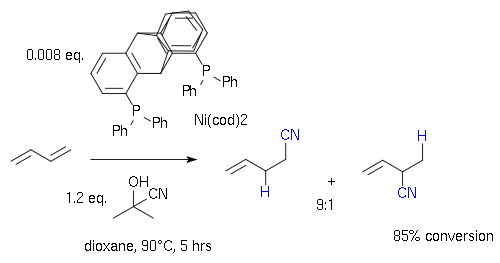
Triptycene
Encyclopedia
Triptycenes are a class of aromatic hydrocarbon
s. The parent compound triptycene is the Diels-Alder reaction
product of anthracene
and benzyne. The compound has a paddlewheel configuration with D3h symmetry
. Barrelene
s are conceptually related compounds.
The hydrocarbon framework is very rigid and triptycene and triptycene derivatives such as triptycene quinones are therefore incorporated in many organic compounds as a molecular scaffold for instance in molecular motor
s or as a ligand
for example in this hydrocyanation
:
Aromatic hydrocarbon
An aromatic hydrocarbon or arene is a hydrocarbon with alternating double and single bonds between carbon atoms. The term 'aromatic' was assigned before the physical mechanism determining aromaticity was discovered, and was derived from the fact that many of the compounds have a sweet scent...
s. The parent compound triptycene is the Diels-Alder reaction
Diels-Alder reaction
The Diels–Alder reaction is an organic chemical reaction between a conjugated diene and a substituted alkene, commonly termed the dienophile, to form a substituted cyclohexene system. The reaction can proceed even if some of the atoms in the newly formed ring are not carbon...
product of anthracene
Anthracene
Anthracene is a solid polycyclic aromatic hydrocarbon consisting of three fused benzene rings. It is a component of coal-tar. Anthracene is used in the production of the red dye alizarin and other dyes...
and benzyne. The compound has a paddlewheel configuration with D3h symmetry
Symmetry group
The symmetry group of an object is the group of all isometries under which it is invariant with composition as the operation...
. Barrelene
Barrelene
Barrelene is a bicyclic organic compound with chemical formula C8H8 and systematic name bicyclo[2.2.2]octa-2,5,7-triene. First synthesized and described by H. E. Zimmerman in 1960 the name derives from the obvious resemblance with a barrel, with the staves being three ethylene units attached to two...
s are conceptually related compounds.
The hydrocarbon framework is very rigid and triptycene and triptycene derivatives such as triptycene quinones are therefore incorporated in many organic compounds as a molecular scaffold for instance in molecular motor
Synthetic molecular motors
Synthetic molecular motors are molecular machines capable of rotation under energy input. Although the term "molecular motor" has traditionally referred to a naturally occurring protein that induces motion , some groups also use the term when referring to non-biological, non-peptide synthetic...
s or as a ligand
Ligand
In coordination chemistry, a ligand is an ion or molecule that binds to a central metal atom to form a coordination complex. The bonding between metal and ligand generally involves formal donation of one or more of the ligand's electron pairs. The nature of metal-ligand bonding can range from...
for example in this hydrocyanation
Hydrocyanation
Hydrocyanation is, most fundamentally, the process whereby H+ and –CN ions are added to a molecular substrate. Usually the substrate is an alkene and the product is a nitrile. When –CN is a ligand in a transition metal complex, its basicity makes it difficult to dislodge, so, in this...
:


